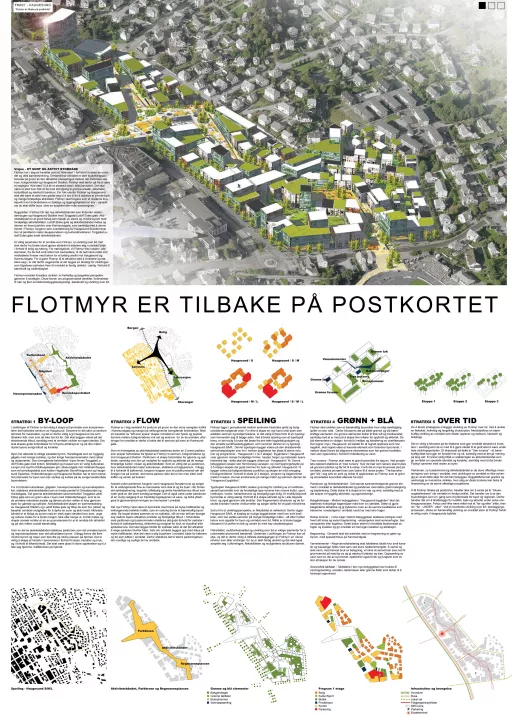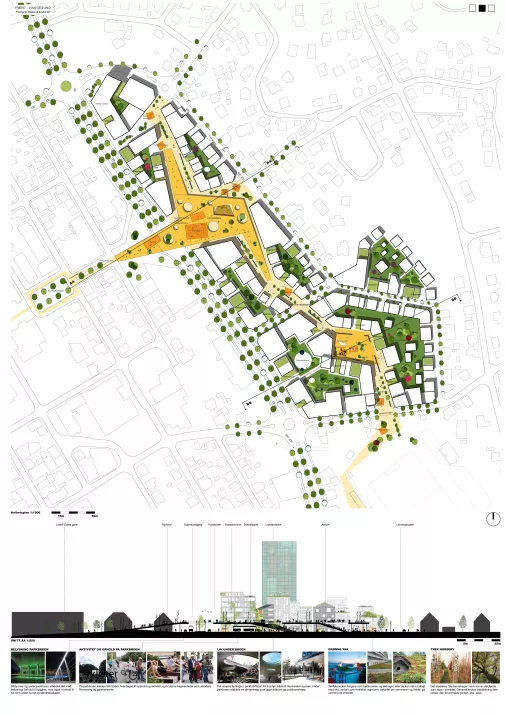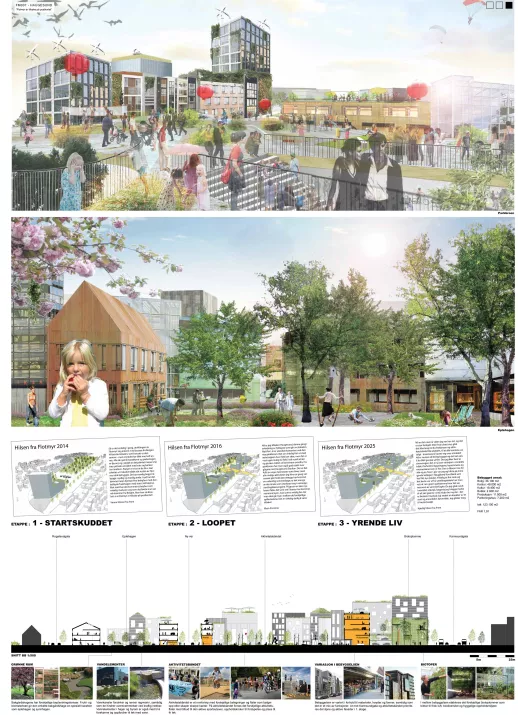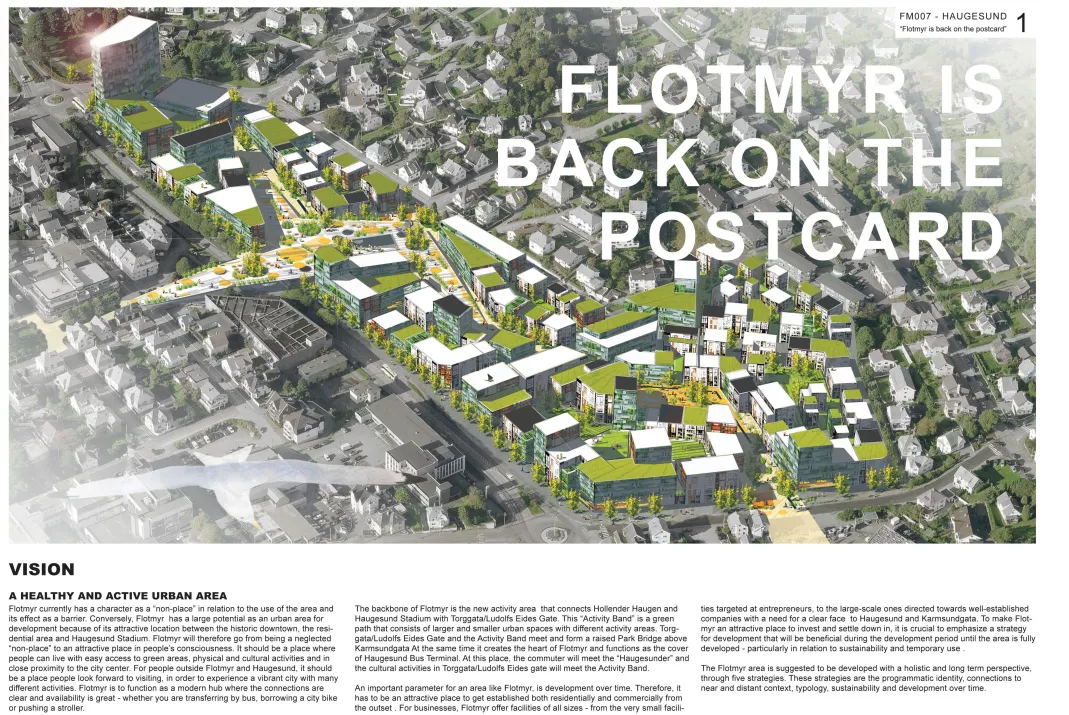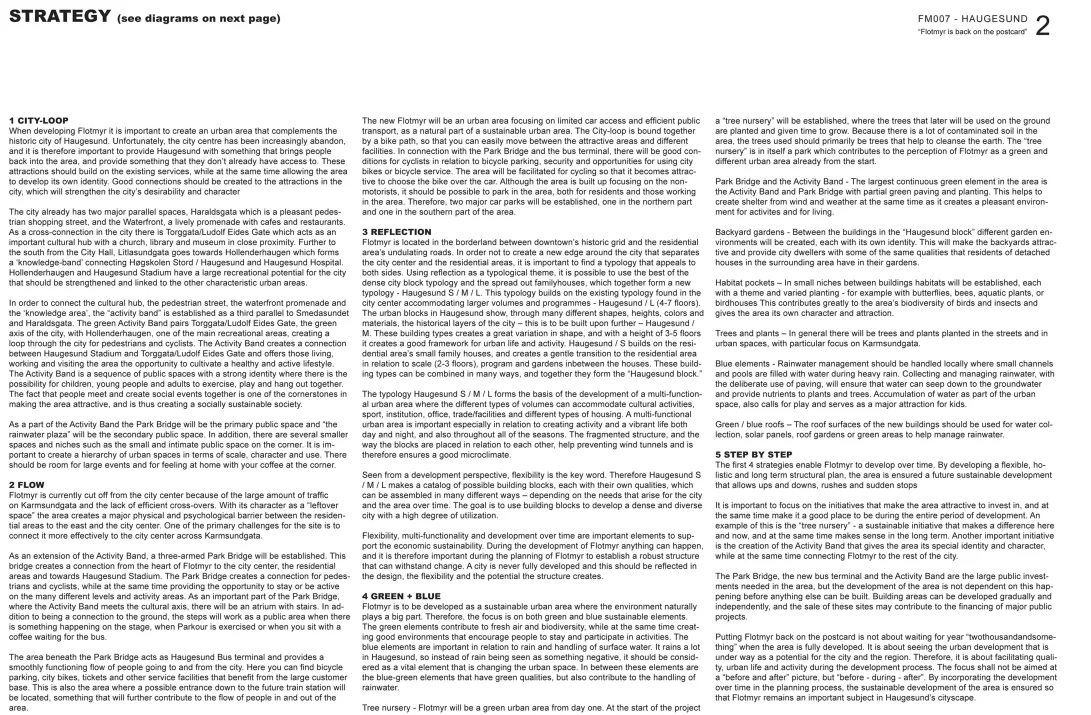Project:
Flotmyr is back on the postcard
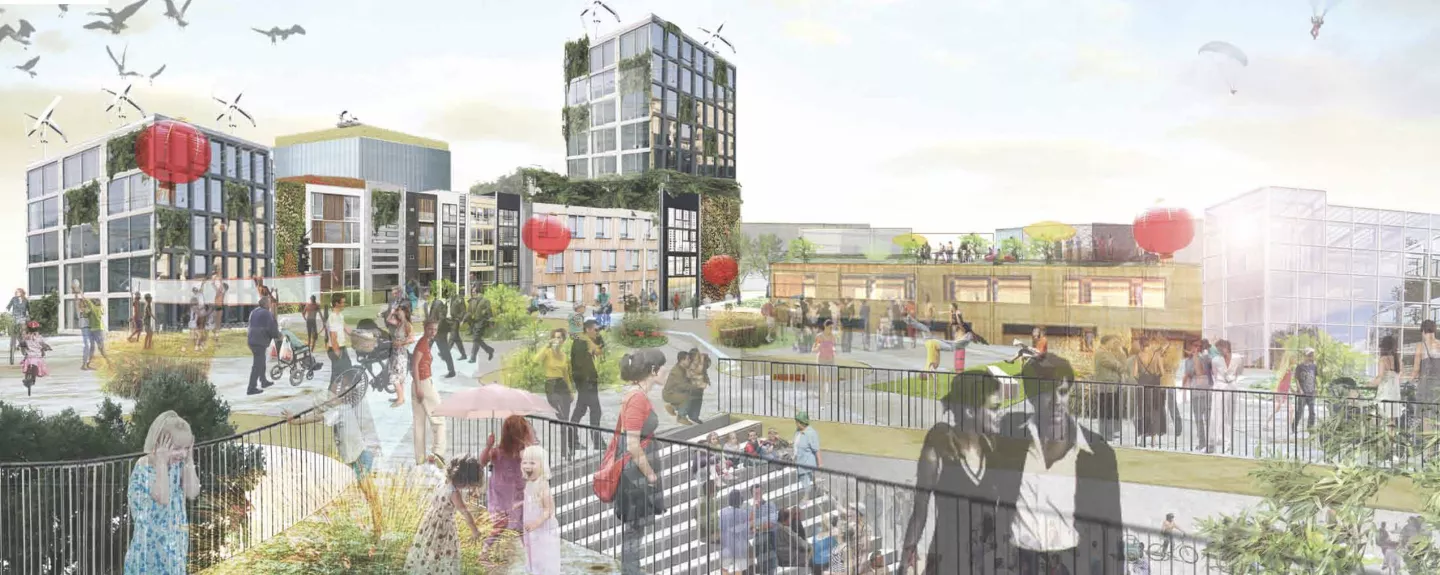
About
-
1 CITY-LOOP
When developing Flotmyr it is important to create an urban area that complements the historic city of Haugesund. Unfortunately, the city centre has been increasingly abandoned, and it is therefore important to provide Haugesund with something that brings people back into the area, and provide something that they don't already have access to. These attractions should build on the existing services, while at the same time allowing the area to develop its own identity. Good connections should be created to the attractions in the city, which will strengthen the city's desirability and character
The city already has two major parallel spaces, Haraldsgata which is a pleasant pedestrian shopping street, and the Waterfront, a lively promenade with cafes and restaurants.
As a cross-connection in the city there is Torggata/Ludolf Eides Gate which acts as an important cultural hub with a church, library and museum in close proximity. Further to the south from the City Hall, Litlasundgata goes towards Hollenderhaugen which forms a 'knowledge-band' connecting Hogskolen Stord / Haugesund and Haugesund Hospital. Hollenderhaugen and Haugesund Stadium have a large recreational potential for the city that should be strengthened and linked to the other characteristic urban areas.
In order to connect the cultural hub, the pedestrian street, the waterfront promenade and the 'knowledge area', the "activity band" is established as a third parallel to Smedasundet and Haraldsgata. The green Activity Band pairs Torggata/Ludolf Eides Gate, the green axis of the city, with Hollenderhaugen, one of the main recreational areas, creating a loop through the city for pedestrians and cyclists. The Activity Band creates a connection between Haugesund Stadium and Torggata/Ludolf Eides Gate and offers those living, working and visiting the area the opportunity to cultivate a healthy and active lifestyle.
The Activity Band is a sequence of public spaces with a strong identity where there is the possibility for children, young people and adults to exercise, play and hang out together. The fact that people meet and create social events together is one of the cornerstones in making the area attractive, and is thus creating a socially sustainable society.
As a part of the Activity Band the Park Bridge will be the primary public space and "the rainwater plaza" will be the secondary public space. In addition, there are several smaller spaces and niches such as the small and intimate public space on the corner. It is important to create a hierarchy of urban spaces in terms of scale, character and use. There should be room for large events and for feeling at home with your coffee at the corner.
2 FLOW
Flotmyr is currently cut off from the city center because of the large amount of traffic on Karmsundgata and the lack of efficient cross-overs. With its character as a "leftover space" the area creates a major physical and psychological barrier between the residential areas to the east and the city center. One of the primary challenges for the site is to connect it more effectively to the city center across Karmsundgata.
As an extension of the Activity Band, a three-armed Park Bridge will be established. This bridge creates a connection from the heart of Flotmyr to the city center, the residential areas and towards Haugesund Stadium. The Park Bridge creates a connection for pedestrians and cyclists, while at the same time providing the opportunity to stay or be active on the many different levels and activity areas. As an important part of the Park Bridge, where the Activity Band meets the cultural axis, there will be an atrium with stairs. In addition to being a connection to the ground, the steps will work as a public area when there is something happening on the stage, when Parkour is exercised or when you sit with a coffee waiting for the bus. The area beneath the Park Bridge acts as Haugesund Bus terminal and provides a smoothly functioning flow of people going to and from the city. Here you can find bicycle parking, city bikes, tickets and other service facilities that benefit from the large customer base. This is also the area where a possible entrance down to the future train station will be located, something that will further contribute to the flow of people in and out of the area.
The new Flotmyr will be an urban area focusing on limited car access and efficient public transport, as a natural part of a sustainable urban area. The City-loop is bound together by a bike path, so that you can easily move between the attractive areas and different facilities. In connection with the Park Bridge and the bus terminal, there will be good conditions for cyclists in relation to bicycle parking, security and opportunities for using city bikes or bicycle service. The area will be facilitated for cycling so that it becomes attractive to choose the bike over the car. Although the area is built up focusing on the non-motorists, it should be possible to park in the area, both for residents and those working in the area. Therefore, two major car parks will be established, one in the northern part and one in the southern part of the area.
3 REFLECTION
Flotmyr is located in the borderland between downtown's historic grid and the residential area's undulating roads. In order not to create a new edge around the city that separates the city center and the residential areas, it is important to find a typology that appeals to both sides. Using reflection as a typological theme, it is possible to use the best of the dense city block typology and the spread out familyhouses, which together form a new typology Haugesund S / M / L. This typology builds on the existing typology found in the city center accommodating larger volumes and programmes - Haugesund / L (4-7 floors).
The urban blocks in Haugesund show, through many different shapes, heights, colors and materials, the historical layers of the city this is to be built upon further Haugesund / M. These building types creates a great variation in shape, and with a height of 3-5 floors it creates a good framework for urban life and activity. Haugesund / S builds on the residential area's small family houses, and creates a gentle transition to the residential area in relation to scale (2-3 floors), program and gardens inbetween the houses. These building types can be combined in many ways, and together they form the "Haugesund block.'
The typology Haugesund S / M / L forms the basis of the development of a multi-functional urban area where the different types of volumes can accommodate cultural activities, sport, institution, office, trade/facilities and different types of housing. A multi-functional urban area is important especially in relation to creating activity and a vibrant life both day and night, and also throughout all of the seasons. The fragmented structure, and the way the blocks are placed in relation to each other, help preventing wind tunnels and is therefore ensures a good microclimate.Seen from a development perspective, flexibility is the key word. Therefore Haugesund S / M / L makes a catalog of possible building blocks, each with their own qualities, which can be assembled in many different ways - depending on the needs that arise for the city and the area over time. The goal is to use building blocks to develop a dense and diverse city with a high degree of utilization.
Flexibility, multi-functionality and development over time are important elements to support the economic sustainability. During the development of Flotmyr anything can happen, and it is therefore important during the planning of Flotmyr to establish a robust structure that can withstand change. A city is never fully developed and this should be reflected in the design, the flexibility and the potential the structure creates.
4 GREEN + BLUE
Flotmyr is to be developed as a sustainable urban area where the environment naturally plays a big part. Therefore, the focus is on both green and blue sustainable elements.
The green elements contribute to fresh air and biodiversity, while at the same time creating good environments that encourage people to stay and participate in activities. The blue elements are important in relation to rain and handling of surface water. It rains a lot in Haugesund, so instead of rain being seen as something negative, it should be considered as a vital element that is changing the urban space. In between these elements are the blue-green elements that have green qualities, but also contribute to the handling of rainwater.5 STEP BY STEP
The first 4 strategies enable Flotmyr to develop over time. By developing a flexible, holistic and long term structural plan, the area is ensured a future sustainable development that allows ups and downs, rushes and sudden stops.
It is important to focus on the initiatives that make the area attractive to invest in, and at the same time make it a good place to be during the entire period of development. An example of this is the "tree nursery" - a sustainable initiative that makes a difference here and now, and at the same time makes sense in the long term. Another important initiative is the creation of the Activity Band that gives the area its special identity and character, while at the same time connecting Flotmyr to the rest of the city.
Putting Flotmyr back on the postcard is not about waiting for year "twothousandandsomething" when the area is fully developed. It is about seeing the urban development that is under way as a potential for the city and the region. Therefore, it is about facilitating quality, urban life and activity during the development process.
The focus shall not be aimed at a "before and after" picture, but "before - during - after". By incorporating the development over time in the planning process, the sustainable development of the area is ensured so that Flotmyr remains an important subject in Haugesund's cityscape. -
The design presents a considered response to the issues addressed in the brief of the competition. It offers a sensitive mediation between the denser urban grid of the historical centre and the lower density residential fabric to the east and south of the site. The scale and typological diversity of the project is appropriate and integrated with the surrounding context while at the same time it potentially structures an urban experience. The scheme links the stadium and adjacent neighbourhoods to the city centre through a spatial sequence incorporating public spaces and green areas that supports close proximity between residential and commercial functions and enables pedestrian and bicycle mobility both from and through the site. Furthermore, it locates the bus station in a position that supports connection to the city centre and fits into the local traffic conditions.
While the consideration of climate-responsive design is mentioned in the proposal, it is not explicitly shown on the drawings or developed in a coherent manner. While the design of the public spaces has the potential to mitigate wind velocities at the pedestrian level, similar considerations have not been applied to the location and shape of the proposed tower. The latter object is likely to have a negative impact on the neighbouring buildings, particularly in terms of the redirection and acceleration of wind and solar shading. The height and extent of the proposed elevated plaza was also questioned by the Jury, as was the quality of the public space beneath it. The goal of establishing a certain diversity and hierarchy in the public spaces, it was discussed, may be achievable with a smaller plaza utilizing fewer resources.
-
Annett Grønnern Olsen (DK)
Katja Engel Zepernick (DK)
Jonas Roar Hansen (DK)
Merete Kinnerup Andersen (DK)Contact information:
www.stwwt.wordpress.com
Related projects
-
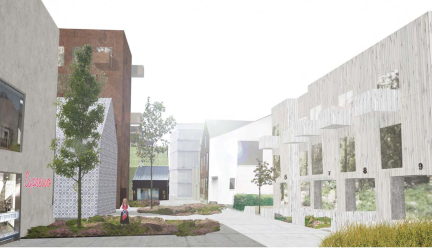
Gardenurbia
GARDENURBIA is public space by working as an interface between urbanity and nature. The public…
-
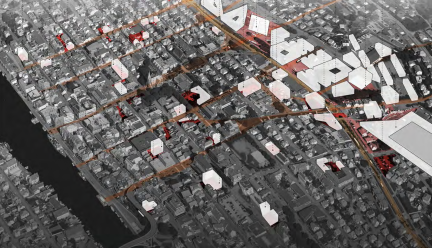
Tales of the unexpected
We propose to set up a gameboard. An active planning department and public participation may over…
-

Flotmyr is back on the postcard
The city centre has been increasingly abandoned, and it is therefore important to provide…
